Bhushan B. Nanotribology and Nanomechanics: An Introduction
Подождите немного. Документ загружается.

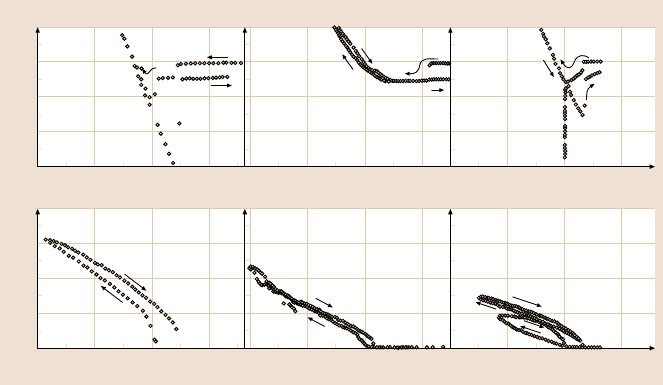
13 Computer Simulations of Nanometer-Scale Indentation and Friction 687
200
0
Z sample position (Å)
Friction (nN)
200
400
800
1000
100 0 100 200 100 0 100 200 100 0 100
ì = 0.6
ì = 0.7
ì = 0.3
MMM
b) d) f)
200
0
Z sample position (Å)
Load (nN)
200
100
0
100
100 0 100 200 100 0 100 200 100 0 100
a) c) e)
Fig. 13.28a–f. Measured values for friction and load as an atomic-force microscope tip is
scanned across a 30 Å-thick sample of perfluoropolyether on Si(100). (a)and(b) The un-
bonded polymer with unreactive end groups. (c)and(d) The unbonded polymer with alcohol
end groups. (e)and(f) A bonded polymer. After [161] with the permission of the APS (1992)
mechanical and atomic-scale frictional properties of DLC coatings. MD simulat-
ions with bond-order potentials by Sinnott et al. [166] examined the differences in
indentationbehaviorof a hydrogen-terminateddiamond tipon hydrogen-terminated
single-crystaldiamond surfacesand diamondsurfaces coveredwith DLC. In the for-
mer case, the tip goes through shear and twist deformations at low loads that change
to plastic deformation and adhesion with the surface at high loads. When the sur-
face is covered with the DLC film, the tip easily penetrates the film, as illustrated in
Fig. 13.29, which “heals” easily when the tip is retracted so that no crater or other
evidence of the indentation is left behind.
MD simulations by Glosli et al. [167] of the indentation of DLC films that are
about 20nm-thick give similar results. In this case a larger, rigid diamond tip was
used in the indentations and was also slid across the surface. During sliding, the tip
plows the surface, which causes some changes to the film not seen during inden-
tation. However, because the tip is perfectly rigid, adhesion between the film and
surface is not allowed which influences the results.
This section shows that repulsive interactions between surfaces covered with
molecular films and proximal probe tips are minimized relative to interactions be-
tween bare surfaces and indentationtips. The lubricationpropertiesof polymers and
SAMs can vary with chain length, the rigidity of the tip, and the chemical proper-
ties of the end groups. In some cases, indentations can disrupt the initial ordering of
polymers and SAMs, which affects their responses to nanoindentation and friction.
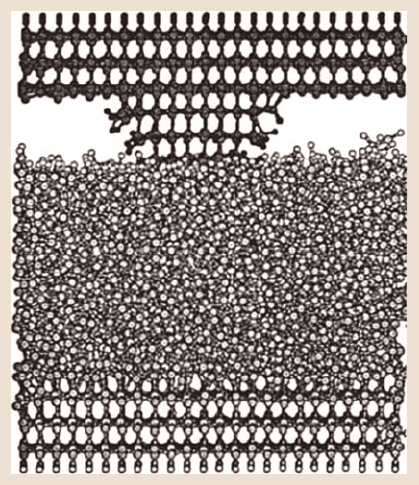
688 Susan B. Sinnott et al.
Fig. 13.29. Snapshot from
a molecular dynamics simu-
lation where a pyramidal
diamond tip indented an
amorphous carbon thin film
that is 20 layers thick. The
simulation took place at room
temperature and the carbon
atoms in the film were 21%
sp
3
-hybridized and 58% sp
2
-
hybridized (the remaining
atoms were on the surface
and were not counted). Af-
ter [166] with the permission
of the AIP (1997)
13.4 Friction and Lubrication
Work is requiredto slide two surfaces againstone another.When the work of sliding
is converted to a less ordered form, as required by the first law of thermodynamics,
friction will occur. For instance, if the two surfaces are strongly adhering to one
another, the work of sliding can be converted to damage that extends beyond the
surfaces and into the bulk. If the adhesive force between the two surfaces is weaker,
the conversion of work results in damage that is limited to the area at or near the
surface and produces transfer films or wear debris [169,170]. While the thermody-
namic principles of the conversion of work to heat are well known, the mechanisms
by which this takes place at sliding surfaces are much less well established despite
their obvious importance for a wide variety of technological applications.
Atomic-scale simulations of friction are therefore important tools for achieving
this understanding. They have consequently been applied to numerous materials in
a wide variety of structures and configurations, including atomically flat and atomi-
cally rough diamond surfaces [171–173], rigid substrates covered with monolayers
of alkane chains [174], perfluorocarboxylic acid and hydrocarboxylic Langmuir–
Blodgett (LB) monolayers [175], between contacting copper surfaces [168, 176],
between a silicon tip and a silicon substrate [116,140], and between contacting di-
amond surfaces that have organic molecules absorbed on them [177]. These and
several other studies are discussed below.
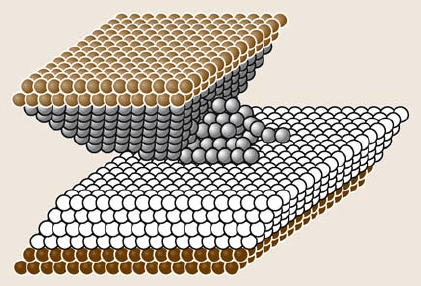
13 Computer Simulations of Nanometer-Scale Indentation and Friction 689
13.4.1 Bare Surfaces
Sliding friction that takes place between two surfaces in the absence of lubricant is
termed “dry” friction even if the process occurs in an ambient environment. Simple
modelshavebeen developedto modeldrysliding friction that,for example,consider
the motion of a single atom over a monoatomic chain [178]. Results from these
models reveal how elastic deformation of the substrate from the sliding atom affects
energy dissipation and how the average frictional force varies with changes in the
force constant of the substrate in the direction normal to the scan direction. Much
of the correct behavior involved in dry sliding friction is captured by these types
of simple models. However, more detailed models and simulations, such as MD
simulations, are required to provide information about more complex phenomena.
MD simulations have been used to study the sliding of metal tips across clean
metal surfaces by numerous groups [168,179–183]. An illustrative case is shown in
Fig. 13.30 for a copper tip sliding across a copper surface [168]. Adhesion and wear
occur when the attractive force between the atoms on the tip and the atoms at the
surface becomes greater than the attractive forces within the tip itself. Atomic-scale
stick and slip can occur through nucleation and subsequent motion of dislocations,
and wear can occur if part of the tip gets left behind on the surface (Fig. 13.30). The
simulations can further provide data on how the characteristic ‘stick-slip’ friction
motion candepend on theareaof contact,the rate of sliding, and thesliding direction
(Fig. 13.31).
An additional study of stick-slip in the sliding of much larger, square-shaped
metal tips across metal surfaces was carried out by Li et al. [184] using EAM poten-
tials. The initial structure of a NiAl tip and surface system is shown in Fig. 13.32.
This study predicted that collective elastic deformation of the surface layers in re-
sponse to sliding is the main cause of the stick-slip behavior shown in Fig. 13.33.
The simulations also predicted that stick-slip produces phonons that propagate
through the surface slab.
Large-scale simulations using pairwise Morse potentials that are similar in form
to (13.6) were used to study the wear of metal surfaces caused by metal tips that
Fig. 13.30. Snapshot from
a molecular dynamics simu-
lation of a copper tip sliding
across a Cu(100) surface.
A connective neck between
the two is sheared during the
sliding, leading to wear of
the tip. The simulation was
performed at a temperature
of 0 K. After [168] with the
permission of the APS (1996)
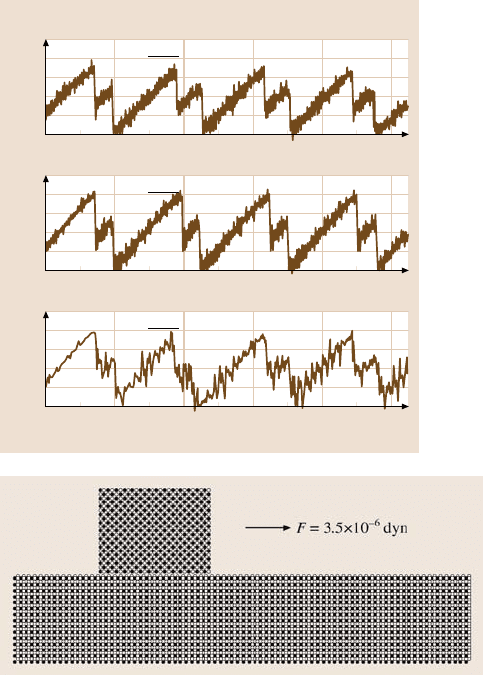
690 Susan B. Sinnott et al.
0
2
Distance (Å)
F
x
(nN)
0
2
4
6
8
c)
2 4 6 8 10
F
x
(nN)
0
2
4
6
8
b)
F
x
(nN)
0
2
4
6
8
a)
300 K, 2 m/s
12 K, 2 m/s
12 K, 10 m/s
2
2
Fig. 13.31a–c. Plots of the
lateral force versus distance
from a simulation similar
to that shown in Fig. 13.30.
The plots illustrate the de-
pendence of the force on
temperature and sliding ve-
locity. After [168] with the
permission of the APS (1996)
Fig. 13.32. Starting configuration of sliding NiAl tip on a NiAl surface. After [184] with the
permission of the AIP (2001)
plowthe surface, asillustrated in Fig. 13.34.Theyprovideinsight into the wear track
dependence of the sliding rate [186] and how variations in the scratching force, fric-
tion coefficient, and other quantities depend on the scratch depth [185],as illustrated
in Fig. 13.35.
On the whole,the results of experimentalstudies show good agreement with the
resultsof the computationalstudies describedabove.Thisis truedespite the factthat
all of these MD simulations use empirical potentials that do not include electronic
effects and thus effectively assume that the electronic contributions to friction on
metalsurfacesare negligible.However,experimentshavemeasured anon-negligible
contribution of conduction electrons to friction [188]. Thus, future simulations of
metal-tip–metal-substrateinteractionsusingmore sophisticatedtight-bindingor first
principles methods that include electronic effects are encouraged.
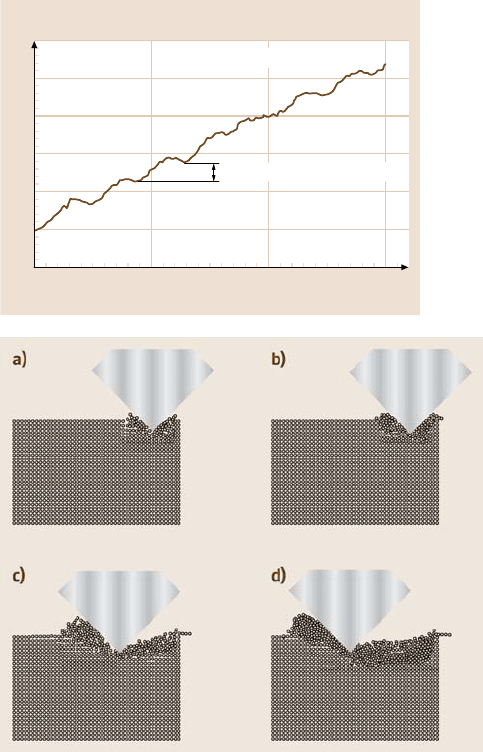
13 Computer Simulations of Nanometer-Scale Indentation and Friction 691
0
5
Time step
X displacement (Å)
0
5
10
15
20
25
30 00010 000 20 000
» Lattice constant of NiAl
F = 3.5×10
6
(dyn)
Fig. 13.33. A structured
curve of frictional dynamics
of an atom in the upper right
corner that is indicative of
stick-slip. After [184] with
the permission of the AIP
(2001)
Fig. 13.34a–d. Snapshots of the scratching of an aluminium surface with a rigid tip at a depth
of 0.8 nm. After [185] with the permission of the APS (2000)
Layered ceramics, such as mica, graphite and MoS
2
, that have structures that
include strongly bound layers that interact with one another through weak van der
Waals bonds, have long been known to have good lubricating properties because of
the ease with which the layers slide over one another. They have, therefore, been the
focus of some of the earliest experimental studies of nanometer-scale friction [19,
189]. The results of these early studies lead researchers to hypothesize that at high
loads measured friction forces were related to “incipient sliding” [190,191] caused
by a small flake from the surface becoming attached to the end of the tip. If true, this
would mean that all measured interactions were between the surface and the flake,
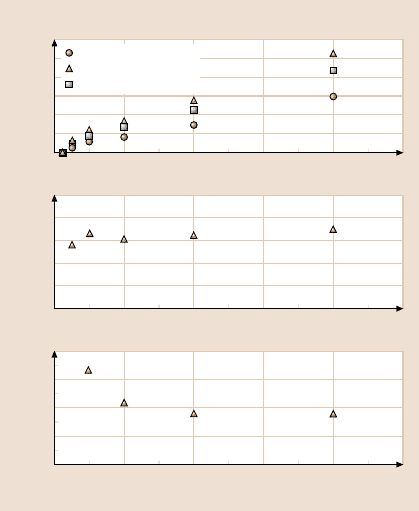
692 Susan B. Sinnott et al.
0
0
Scratch depth (nm)
Specific energy (GPa)
c)
10
20
30
40
0.2 0.4 0.6 0.8 1
0
Force ratio (F
s
/F
n
)
b)
1
0
Force/unit width (N/mm) 3×10
2
a)
1
0.2
0.4
0.6
0.8
0.5
1
1.5
2
2.5
3
Scratch force (F
s
)
Resultant force (F
R
)
Nominal force (F
n
)
Fig. 13.35. Variationin(a)
the scratching force, the nor-
mal force, and the resultant
force, and (b) the friction co-
efficient, and (c) the specific
energy during scratch pro-
cesses similar to those shown
in Fig. 13.34 at scratch depths
ranging from 0.8nmtoal-
most 0 nm. After [185] with
the permission of the APS
(2000)
which has a larger contact area than the clean tip. However, subsequent simulations
of constant force AFM images of graphite by Tang et al. [192] showed that there
is no need for the assumption of a graphite flake under the tip to reproduce the
experimental images of a graphite surface.
Surprisingly strong localized fluctuations in atomic-scale friction are displayed
by layered ceramics [187, 194–196]. For instance, square-well signals with sub-
angstrom lateral width are obtained in FFM scans on MoS
2
(001) in the direction
across the scan direction, while sawtooth signals are detected along the scan direc-
tion, as shown in Fig. 13.36. This finding can be explained by a stick-slip model
by Mate [19] and Erlandsson [189] that assumes that the tip does a zigzag walk
along the scan. Measured variations in the frictional force with the periodicity of
cleavage planes [189] are consistent with the results of this simple model. How-
ever, additional experiments indicate a more complex tip–surface interaction, such
as changes in the intrinsic lateral force between the substrate and the AFM tip [197]
or sliding-induced chemistry between the tip and the surface [198,199].
Crystalline ceramics differ from layered ceramics in that they are held together
by relatively strong covalent or ionic bonds. In the case of ionic systems, Shluger
et al. [193] used a mixture of atomistic and macroscopic modeling methods to study
the interaction of a MgO tip and a LiF surface. In particular, the tip–surface in-
teraction was treated atomistically and the cantilever deflection was treated with
a macroscopic approach. The results, shown in Fig. 13.37, show that if the tip is
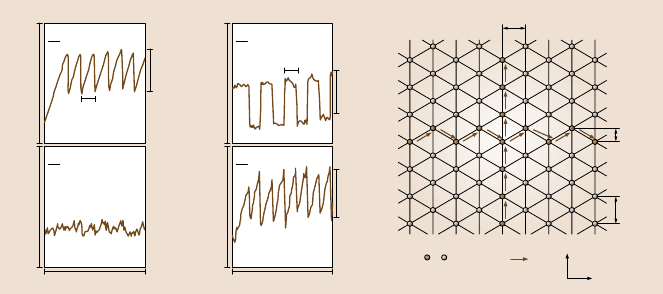
13 Computer Simulations of Nanometer-Scale Indentation and Friction 693
f
x
k
x
9.2 Å
a) b) c)
3.16 Å
3.16 Å
f
y
k
y
6.9Å
f
x
k
x
4.6Å
1.58 Å
f
y
k
y
6.9 Å
2.74 Å
25 Å 25 Å
2.74Å
2.74Å
1.58 Å
3.16 Å
Stick-point Slip-motion
x
y
Fig. 13.36a–c. Displacement data from a scan across a MoS
2
(001) surface. The data in (a)
and (b) are form scans along the x -and y-directions, respectively, on the surface shown in
(c). After [187] with the permission of the APS (1996)
charged and in hard contact with the surface, tip and surface distortions are possible
that can lead to motion of the surface ions within the surface plane and the transfer
of some of the ions onto the tip.
In the case of covalently bound ceramics, there is extensive literature related to
friction of diamond [200,201] because, while it is the hardest material known, it
also exhibits relatively low friction. The “ratchet mechanism” has been proposed
for energy dissipation during friction on the macroscale in diamond, where energy
is released by the transfer of normal force from one surface asperity to another. The
elastic mechanismis anothermechanism that has been proposed, where the released
energycomesfrom elastic strain in an asperity.Atomic-scale frictionhas been meas-
ured experimentally [20] for diamond tips with near atomic-scale radii sliding over
hydrogen-terminated diamond surfaces. These experiments are sensitive enough to
detect the 2×1 reconstruction on the diamond (100) surface. Furthermore, the aver-
age friction coefficient determined with an AFM on H-terminated diamond (111)
surfaces is about two orders of magnitude smaller than the value measured on bare,
2×1 diamond (111) surfaces, indicating greater adhesion in the latter case [202].
More recently, the friction between a tungsten carbide tip and hydrogen-terminated
diamond (111) was examined with AFM in UHV by Enachescu et al. [203]. The
friction between these two hard surfaces was shown to obey Derjaguin–Muller–
Toporov or DMT [204] contact mechanics and the shear strength of the interface
was determined to be 246MPa.
Extensive MD simulations have been carried out by Harrison and cowork-
ers that examine the friction between hydrogen-terminated diamond (111) sur-
faces [171, 208] and diamond (100) surfaces [205] in sliding contact. The simu-
lations of sliding between the diamond (111) surfaces reveal that the potential
energy,load,and frictionare allperiodicfunctionsof theslidingdistance(Fig.13.38).
Maxima in thesequantities occur when the hydrogenatoms on opposingsurfacesin-
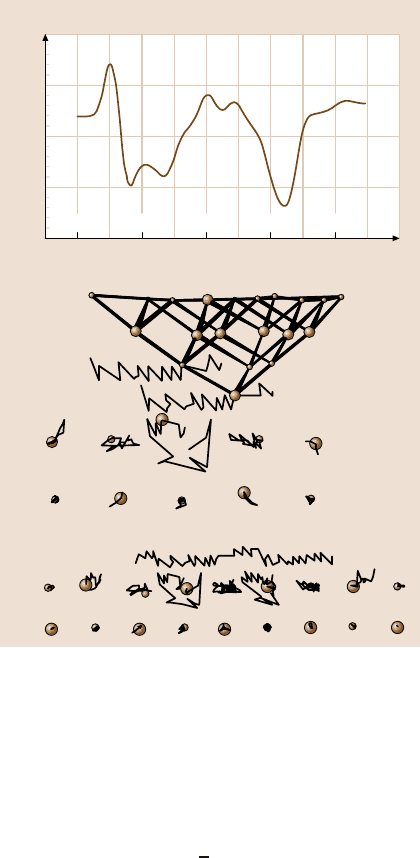
694 Susan B. Sinnott et al.
1
5
Lateral tip displacement along the (100)axis (Å)
a)
2.5
0
2.5
5
Lateral force (nN)
10
0 123456789
Li F Li F Li
b)
Mg
2+
F
+
Li
+
Li
+
F
+
O
2
O
2
Fig. 13.37. Top: The lat-
eral force calculated for
a MgO tip scanning in the
001-direction on LiF(001).
Bottom: A view of the side of
the surface plane along the
scan direction. The surface
Li
+
and F
−
atoms are seen to
relax to relieve the frictional
energy and this relaxation
motion is indicated in the
figure by the category lines.
(a)HowaF
−
iononthe
surface can be moved into an
interstitial site by the tip and
then it returns to its original
position. (b) How the relax-
ation of the surface atoms is
reversible. After [193] with
the permission of Elsevier
(1995)
teract strongly. Recent ab initio studies by Neitola and Park of the friction between
hydrogen-terminated diamond (111) surfaces also show that the potential energy is
periodic with sliding distance (Fig. 13.39) [206]. Because the results of the ab initio
studies and the MD simulations are in good agreement, Neitola and Park conclude
that the potential model used in the MD studies is accurate.
As mentioned previously, the maxima in the load and the friction values dur-
ing sliding are caused by the interactions of hydrogen atoms on opposing surfaces.
When sliding in the [11
2] direction, the H atoms “revolve” around one another,
thus decreasing the repulsive interaction between the sliding surfaces because the
hydrogen atoms are not forced to pass directly over one another [171]. Increasing
the load causes increased stress at the interface. The opposing hydrogen atoms be-
come “stuck”. Once the stress at the interface becomes large enough to overcome
the hydrogen–hydrogeninteraction between opposingsurfaces, the hydrogenatoms
“slip” past one another with the same “revolving” motion observed at low loads.
This phenomenon is known as atomic-scale stick-slip and has the periodicity of the
diamond lattice. It should be noted that due to the alignment of the opposing sur-
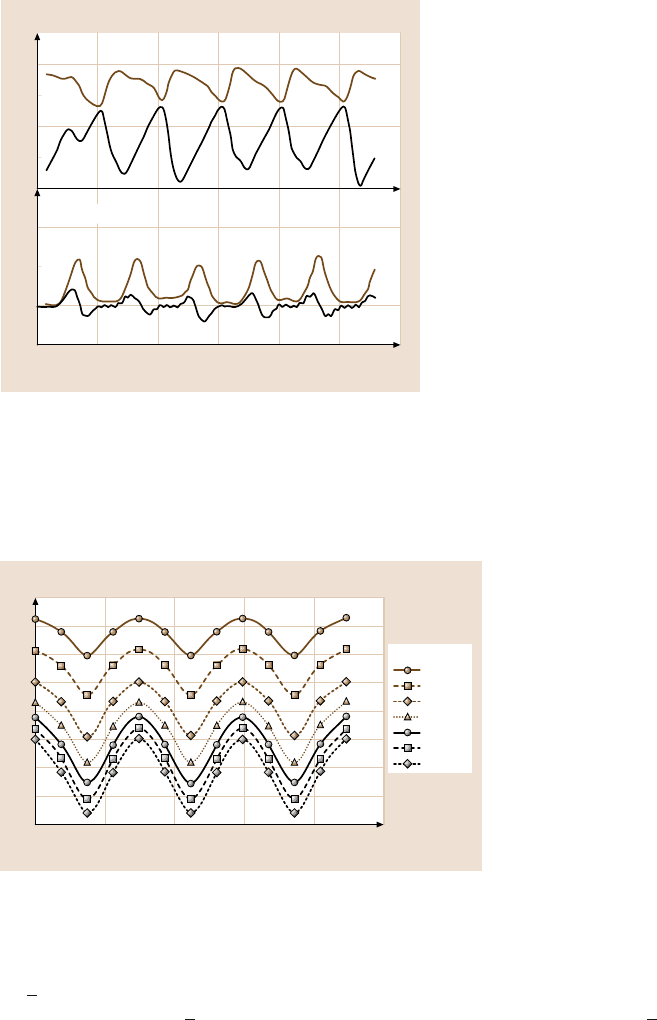
13 Computer Simulations of Nanometer-Scale Indentation and Friction 695
0
Sliding distance / unit cell length
Force (nN/atom)
0
0.5
0
0.5
1
1 2 3 4 5 6
y or [112
]
Fig. 13.38. Calculated frictional force (lower lines) and normal force (upper lines)feltby
a hydrogen-terminated (111) surface as it slides against another hydrogen-terminated dia-
mond (111) surface in a MD simulation. The sliding direction is given in the legend. The
sliding speed is 1Å/ps and the simulation temp is 300 K. The two plots show how the simu-
lated stick-slip motion changes as a function of the applied load. The load is high and low in
the upper and lower panels, respectively. After [205] with the permission of the ACS (1995)
0
3
Sliding distance (Å)
Distance between surfaces (Å)
3.2
3.4
3.6
3.8
4
4.2
4.4
4.6
0.8 nN
1.7 nN
3.3 nN
5.0 nN
6.6 nN
8.3 nN
10.0 nN
Normal load
246810
Fig. 13.39. Distance between hydrogen-terminated (111) crystals as a function of sliding
distance. After [206] with the permission of the ACS (2001)
faces, the hydrogen atoms are directly in line with each other when sliding in the
[11
2] direction. However, the hydrogen atoms are not “aligned” with each other
when sliding in the [11
0], so the friction in this direction is lower than in the [112]
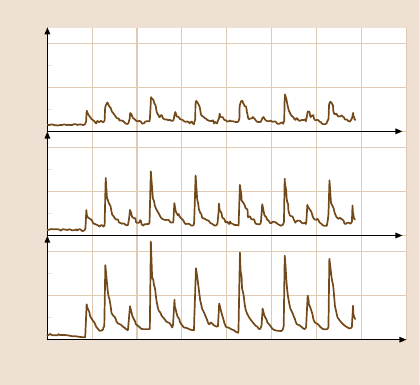
696 Susan B. Sinnott et al.
direction. It should be noted, however, that experimentally all initial alignments are
likely to be probed.
Harrison and coworkershavefurther shown that the peaks in the frictional force
are correlated with peaks in the temperature of the atoms at the interface when
two hydrogen-terminated diamond (111) surfaces are in sliding contact [208]. Fig-
ure 13.40 shows the vibrational energy (or temperature) between diamond layers as
a function of sliding distance. These data clearly showthat layers close to the sliding
interface can be vibrationally excited during sliding. When the hydrogen atoms are
“stuck” or interacting with each other strongly, the stress and friction force at the
interface build up. When the hydrogen atoms “slip” past one another, the stress at
the interface is relieved and the energy is transferred to the diamond in the form of
vibration or heat. Thus, the peaks in the temperature occur slightly after the peaks
in the frictional force.
It should be noted that atomic-scale stick slip is observed in other systems.
Harrison and coworkers used MD simulations to demonstrate that two hydrogen-
terminated diamond (100) (2 × 1) surfaces in sliding contact also exhibit stick-
slip [205]. In addition, it was shown that the shape of the friction versus sliding
distance curves is influenced slightly by the speed of the sliding, with features in the
curves becoming more pronounced at slower speeds. Stick-slip behavior was also
observed in AFM studies of diamond (100) (2×1) surfaces [202]. However, in this
0
0
Sliding distance / unit cell
Vibrational energy (K)
500
1000
0
500
1000
0
500
1000
2468
C
3
C
4
C
2
C
3
H
1
C
2
Fig. 13.40. Average vibrational energy of oscillators between diamond layers as a function
of sliding distance. These energies are derived from a molecular dynamics simulation of the
sliding of a hydrogen-terminated diamond (111) surface over another hydrogen-terminated
diamond (111) surface. The vibrational energy between the first and second layers of the
lower diamond surface is shown in the lower panel, between the second and third layers in
the middle panel, and between the third and fourth layers in the upper panel. After [207] with
the permission of Elsevier (1995)
